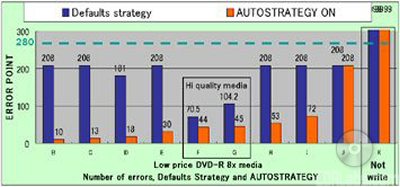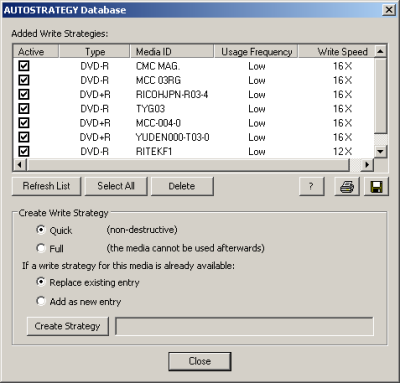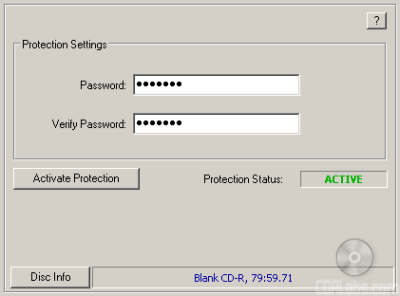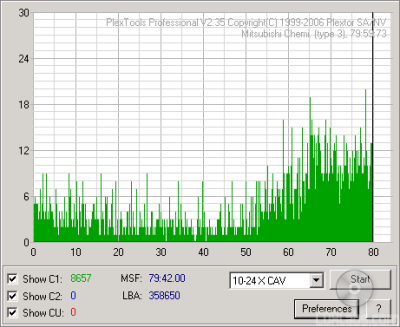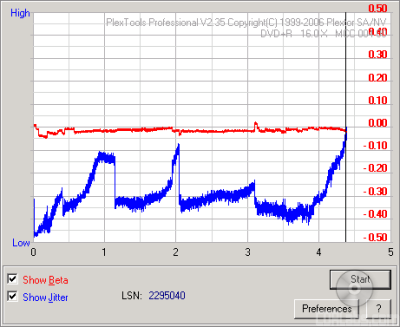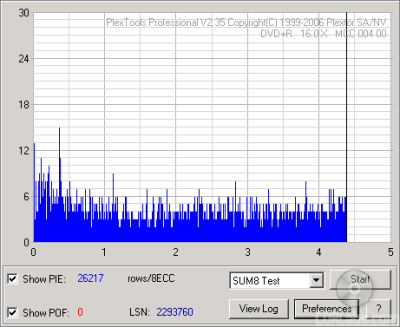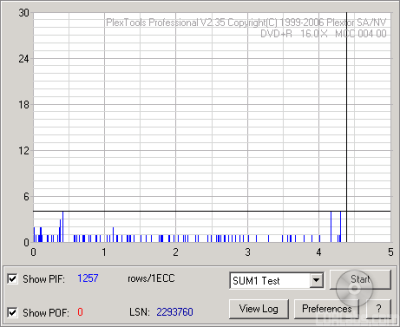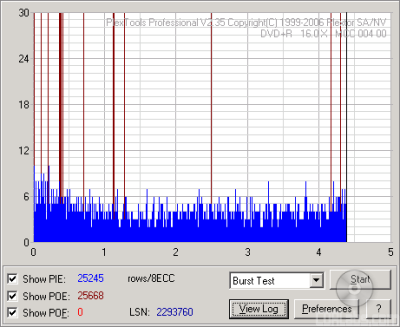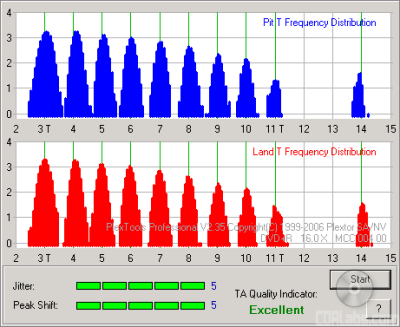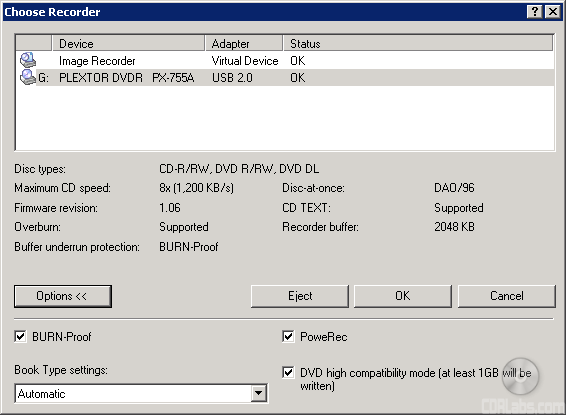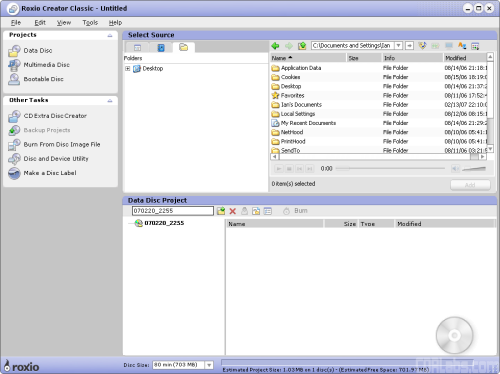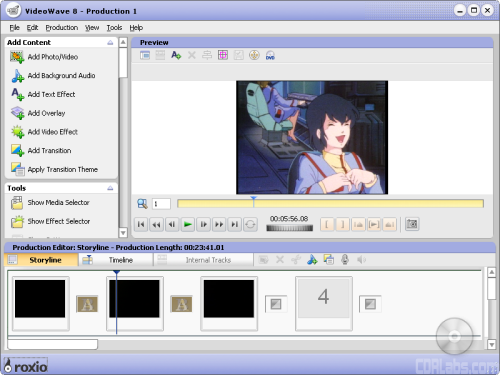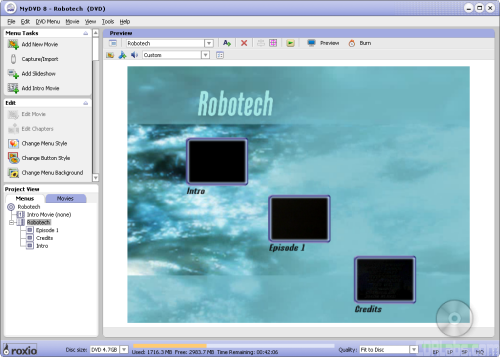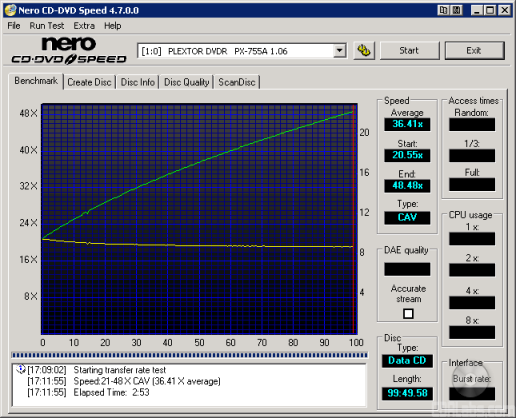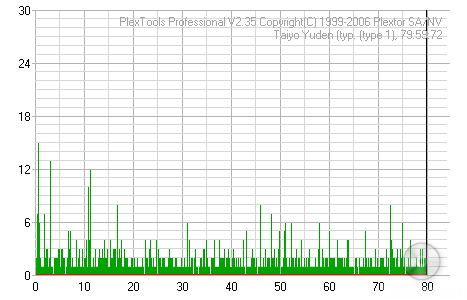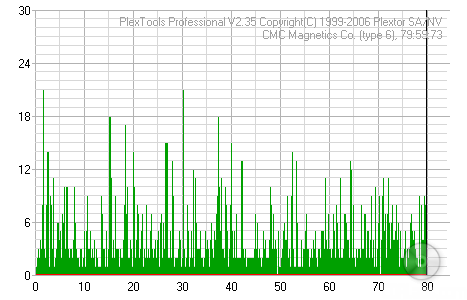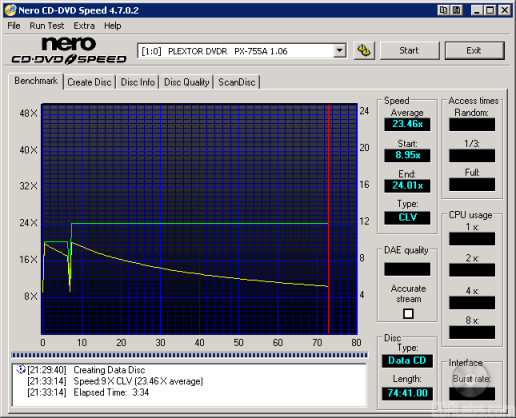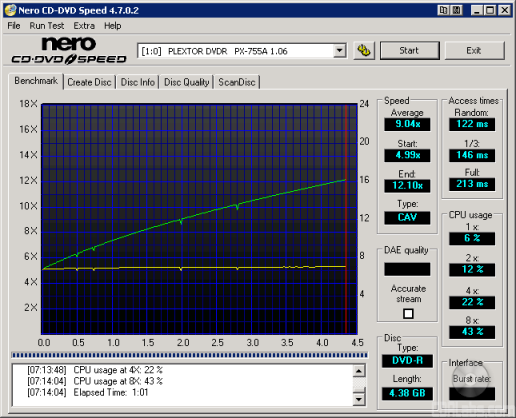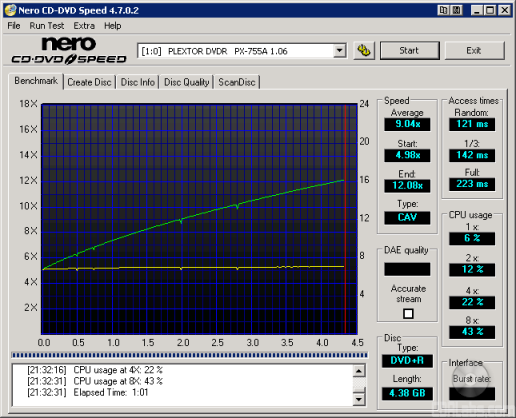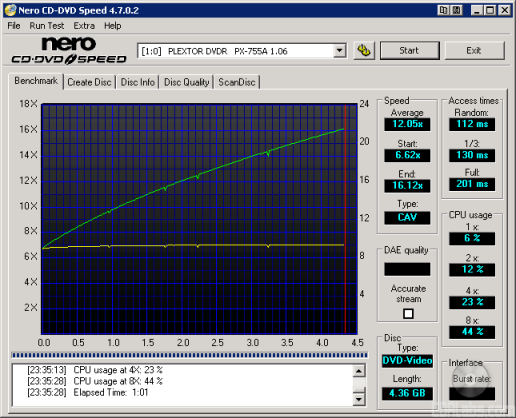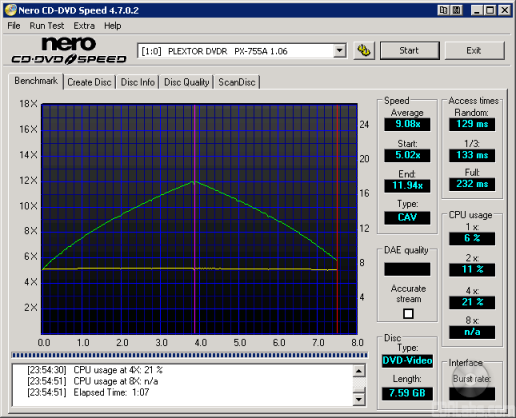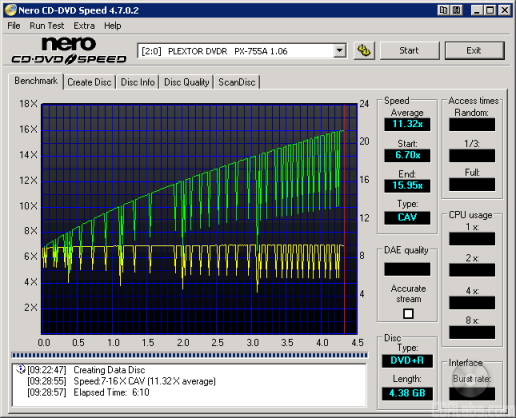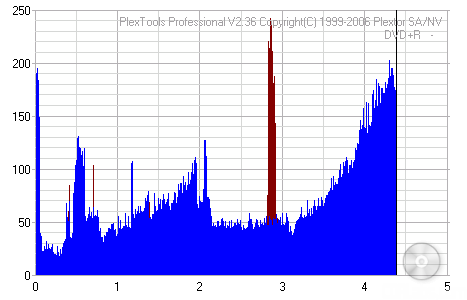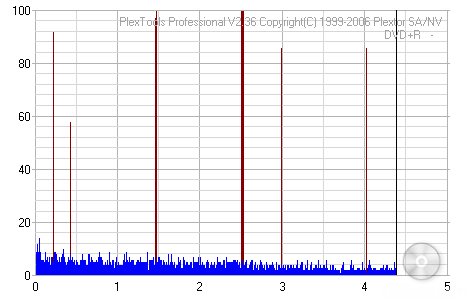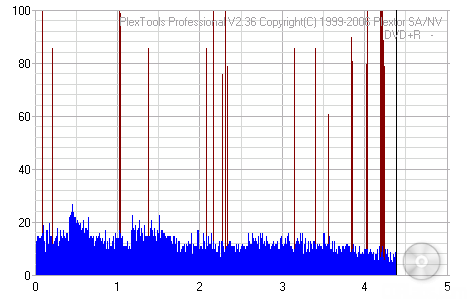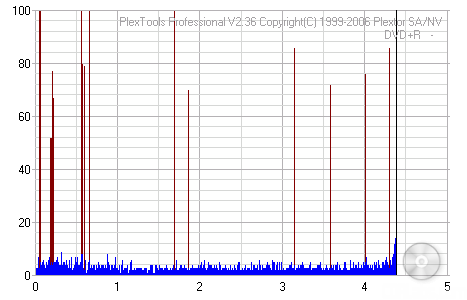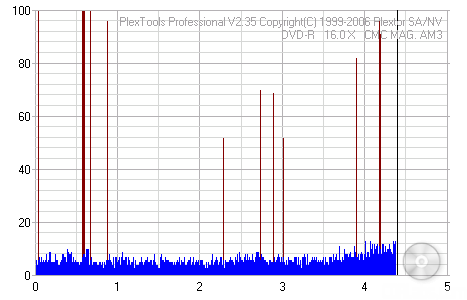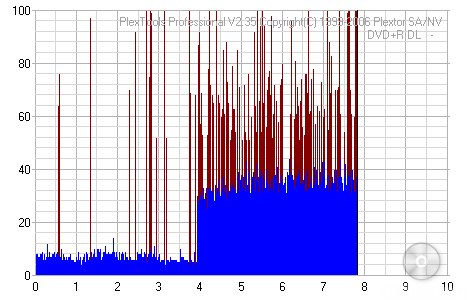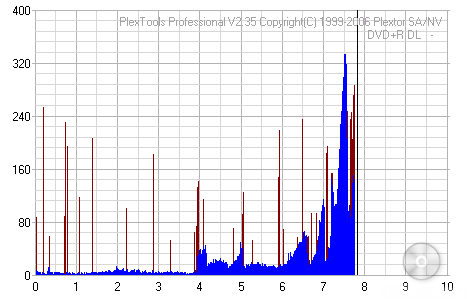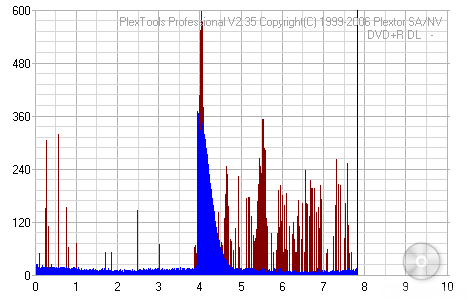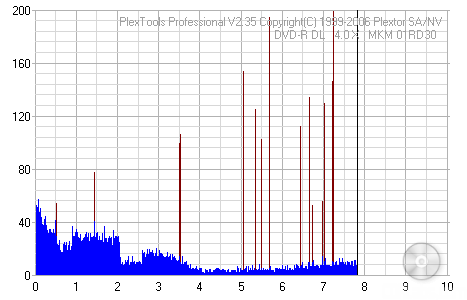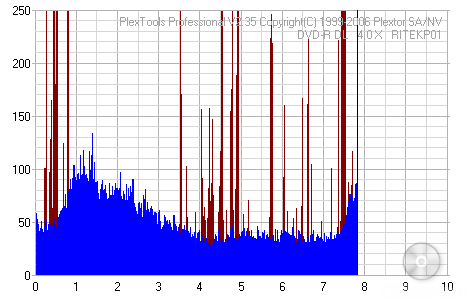Model: Plextor PX-755UF 16x FireWire/USB 2.0 DVD±RW
Manufacturer: Plextor
Provided By: Plextor LLC
When it comes to optical storage, the name Plextor stands head and shoulders above the rest. For more than a decade, they've produced some of the best drives the industry has seen. Known the world over for their quality, performance and features, these drives have become favorites among consumers and professionals alike. To keep ahead of the competition, Plextor has repeatedly raised the bar, introducing drives with faster writing speeds and cutting edge technologies that are found nowhere else.
One of the latest additions to Plextor's already impressive line of DVD writers is the PX-755UF. Sporting the same specs as its internal counterpart, the PX-755A, this new external drive is capable of 16x DVD±R, 8x DVD+RW, 6x DVD-RW, 10x DVD+R DL and 6x DVD-R DL writing speeds and a maximum DVD read speed of 16x. As part of Plextor's "Premium" series of drives, the PX-755UF also boasts an impressive list of features. Along with old favorites like VariRec and PoweRec, the PX-755UF supports a number of more advanced technologies like GigaRec, Q-Check and AUTOSTRATEGY.
Needless to say, this is only a taste of what Plextor's new external DVD writer has to offer. To give you an idea of what to expect from the PX-755UF, we'll take a look at some of its features and then see how it stacks up against some of the DVD±RW drives from the competition. Can the PX-755UF deliver the performance and features that we've come to expect from Plextor? Keep reading as we find out.
What's in the box?:
- Plextor PX-755UF 16x DVD±RW Drive
- Quick Installation Guide
- Plextor DVD Writing Software - Revision 13.01
- Data USB 2.0 Cable
- Power USB 2.0 Cable
- AC Adapter And Power Cord
Physical Features:
The drive Plextor sent us for this review was manufactured in November of 2006 and had firmware version 1.06. It was also manufactured in China and had a TLA# of "0006." For this review, we used firmware versions 1.06 and 1.07.
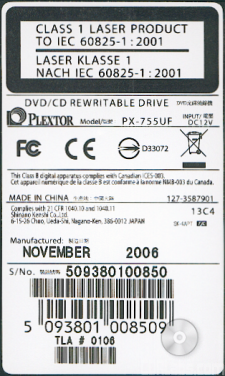
By looking at the front of the PX-755UF you can see that it is based on Plextor's internal 16x DVD±RW, the PX-755A. While the two drives share the same bezel design, there are no logos at all on the front of the PX-755UF.
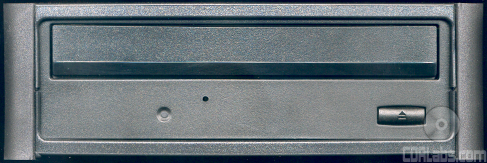
The PX-755UF also has a single LED, which does double duty for both reading and writing activities.This LED lights up yellow when reading, ejecting or initializing a disc, green when its Buffer Under Run Proof is working, and amber when writing. Like with Plextor's other drives, you can determine the PX-755UF's writing speed by monitoring the blink rate of the LED.
| Blink interval | Write Speed | ||
| Amber, 40ms |
|
||
| Amber, 80ms |
|
||
| Amber, 150ms |
|
||
| Yellow | Eject, Initialize, Read | ||
| Green | Standby, Buffer Under Run Proof is working |
||
| Yellow-Green-Amber | Write setting created by AUTOSTRATEGY |
Measuring 6.58" x 2.09" x 9.98" (167.1mm x 53.0mm x 253.5mm) and weighing in at 3.53 lbs (1600 g), the PX-755UF is not the most compact or lightweight external drive we've tested. Nevertheless, the case is constructed of a durable black plastic that should stand up well to everyday use.
 |
 |
If you look closely, you can see that there is another LED on the top of the PX-755UF. This LED lights up a bright blue when the drive is powered on. On each corner of the drive is a rubber strip. This strip not only keeps the PX-755UF planted on your desk, it lets you position it either horizontally or vertically.
The rear of Plextor's new external writer also has its share of connectors. Starting from the left, you can see the PX-755UF's FireWire ports, interface switch, USB 2.0 connector, on/off switch and power connector. I was a little surprised to see that the drive had a cooling fan, especially considering its power supply is located outside of the case in a small "power brick."
Technical Specs:
Most of the specs below have been taken from Plextor's website and the manual that came with the drive.
| Plextor PX-755UF 16x DVD±RW | |
| CD Write Speeds | 48x (CAV) 32x, 24x (P-CAV) 16x, 8x, 4x (CLV) |
| CD Rewrite Speeds | 24x (Z-CLV) 10x, 4x (CLV) |
| DVD+R Write Speeds | 16x (CAV) 12x, 8x (P-CAV) 6x, 4x, 2.4x (CLV) |
| DVD+RW Write Speeds | 8x (P-CAV) 6x, 4x, 2.4x (CLV) |
| DVD-R Write Speeds | 16x (CAV) 12x, 8x (P-CAV) 6x, 4x, 2x (CLV) |
| DVD-RW Write Speeds | 6x, 4x, 2x, 1x (CLV) |
| DVD+R DL Write Speeds | 10x, 8x (P-CAV) 6x, 4x, 2.4x (CLV) |
| DVD-R DL Write Speeds | 6x, 4x, 2x (CLV) |
| CD Read Speeds | 48x, 40x, 32x, 24x (CAV) 8x, 4x (CLV) |
| DAE Speeds | 40x, 32x, 10x (CAV) 8x, 4x (CLV) |
| DVD Read Speeds | 16x Max (DVD-ROM Single Layer) 12x Max (DVD-ROM Dual Layer) 12x Max (DVD-R/RW) 12x Max (DVD+R/RW) 8x Max (DVD+R DL) |
| Buffer Size | 2 MB |
| Access Times |
100 ms (CD) 150 ms (DVD) |
| CD Formats | CD-DA CD-ROM Mode-1 CD-ROM Mode-2 CD-ROM XA CD-Extra Video CD Photo CD Multi-session CD-I CD+G CD-Text CD-R CD-RW |
| DVD Formats | DVD-ROM DVD-Video DVD-R/RW DVD+R/RW DVD+R DL DVD+VR DVD-VR |
| CD Recording Modes | Track At Once Session At Once Disc At Once Variable and Fixed Packet Writing |
| DVD+R Recording Modes | Disc At Once Multi-session Incremental Recording |
| DVD+RW Recording Modes | Random Access Write Sequential Write |
| DVD+R DL Recording Modes | Disc At Once Multi-session Incremental Recording |
| DVD-R Recording Modes | Disc At Once Incremental Recording Multi-border Recording |
| DVD-RW Recording Modes | Disc At Once Incremental Recording Multi-border Recording Restricted Overwriting DRT-DM |
| DVD-R DL Recording Modes | Sequential Write |
The PX-755UF has many of the features found on Plextor's other drives. Along with old favorites like BURN-Proof, PoweRec and VariRec, it supports a number advanced technologies like GigaRec, SecuRec, Q-Check and AUTOSTRATEGY.
While Plextor works hard to add support for as much media as they can, they can't possibly test all of it and include it in the firmware. For this unsupported, or unknown, media there is AUTOSTRATEGY technology. Developed by Taiyo Yuden, AUTOSTRATEGY automatically tests and catalogs unknown media, developing a writing strategy on the fly.
The way AUTOSTRATEGY works is fairly straight forward. When you insert an unknown DVD+R or DVD-R disc (rated at 4x or faster) into the PX-755UF, it will read the manufacturer ID and perform an OPC, or Optical Power Calibration, test to determine the correct laser power. AUTOSTRATEGY then checks to see if the disc's information is already stored in the drive's memory. If not, it will do a trial write and start calculating a writing strategy. From here, the PX-755UF will start writing the data to disc. During this time, AUTOSTRATEGY continually monitors the process via ROPC and PoweRec and will modify the writing strategy if need be. Once done, it will save this writing strategy to memory.
With the PX-755UF, Plextor has expanded the number of AUTOSTRATEGY settings. By default, the drive will automatically select the best writing strategy, no matter if it is located in memory or the firmware. Looking at the screenshot above, you can see that AUTOSTRATEGY can also be turned on (forced), on or off. When forced on, AUTOSTRATEGY will create a new writing strategy every time, even if one already exists in memory.
While the PX-755UF holds a maximum of 31 writing strategies, you don't have to worry about filling up the drive's memory. AUTOSTRATEGY automatically erases little used entries to make room for new ones. Otherwise you can view, deactivate or delete the writing strategies manually using PlexTools.
For the PX-755UF, Plextor has brought back their PoweRec technology. PoweRec stands for Plextor Optimized Writing Error Reduction Control. This technology checks the quality of the media and automatically selects the optimum writing speed. When you insert a disc into the drive, PoweRec identifies the media and compares it to a large database of supportedmedia stored in the firmware. This database includes information about the media, including its maximum recording speed.If not supported, the drive will run OPC tests to check the characteristics and current conditions. From this it can choose the best laser power and speed for the media being used.
PoweRec also monitors the media on the fly by checking the writing quality at set intervals. If it detects that the drive is creating too many write errors, it will modify the writing strategy and laser power, keeping the writing quality at an optimum level.
Plextor's new DVD writer also features their VariRec, or Variable Recording, technology. This technology not only improves the quality of recorded audio and data by minimizing jitter and reducing error rates, it also allows the user to manually adjust the drive's laser power.
Basically a setting of 0 is what VariRec believes the laser power should be for the CD media currently being used. Of course, you can fine tune this even further by manually adjusting the laser power. By doing this, as well as running comparison tests, you can find the setting that delivers the best results for your CD player.
The PX-755UF also offers a number of expanded VariRec features, including an 8x recording speed for CD-R discs. With PlexTools, you can also adjust the laser power up to 4 degrees in either direction and choose a custom recording strategy depending on media being used. Just keep in mind that VariRec only supports write once media and writes in either Track-at-Once (TAO) or Disc-at-Once (DAO) mode.
To put it simply, Plextor's GigaRec technology can increase the capacity of your CD-R media by up to 40%. For example, if you're using a standard 80 minute disc that is 700MB in size, GigaRec will let you squeeze almost 1GB of data, or 111 minutes of audio, onto it.
While this technology has been around for a number of years, Plextor has been pretty tight lipped about how this works. According to some of the documentation Plextor has provided, GigaRec ignores the information encoded onto the CD (manufacturer, maximum write capacity, etc) and compresses the size of the pits and lands on the disc. By doing this, it can "extend" the capacity of the media.
GigaRec also lets you burn a disc at a lower than rated capacity. For example, it can take a disc image that would normally be only 490MB in size and "stretch" it so that it will take up an entire 700MB disc. This changes the length of the pits and lands, which can increase accuracy and data response. According to Plextor, this can result in a truer burn.
While GigaRec has its advantages, it also has a few limitations. When activated, the maximum writing speed is limited to 8x and the only recording mode available is DAO (Disc At Once). On top of that, the drive's buffer underrun protection is turned off. GigaRec's biggest limitation, though, is compatibility. While discs recorded with GigaRec are playable in most of Plextor's newer CD-RW and DVD±RW drives, they might not work in drives from other manufacturers. From past experiences, we found that the higher the GigaRec rate, the lesser the chance the disc was readable by other drives.
Plextor's SecuRec technology lets you protect the data on a CD-R disc with a password. To view the contents of the CD, the user must enter the correct password first. This password can be entered through PlexTools Professional or the SecuViewer client.
SecuRec only supports data CD-R discs written using the Disc At Once recording mode. You will not be able to protect DVD discs, audio CD's or data discs written using Track At Once.
The PX-755UF is one of the first drives to feature Plextor's PlexEraser technology. Developed for security-conscious organizations and individuals, PlexEraser destroys the data on CD-R, DVD±R and DVD±R DL media without physically damaging the disc itself. To do this, it uses the drive's laser beam to "re-record" over the lead-in and data sectors, rendering the disc unreadable and unrecoverable.
While Plextor's new DVD writer is normally pretty quiet, the sound coming from the drive can be reduced even further using Silent Mode. By enabling this feature through PlexTools Professional, you can modify the drive's tray load/unload speed, spin up/down speed and write/read speeds.
 Silent Mode CD |
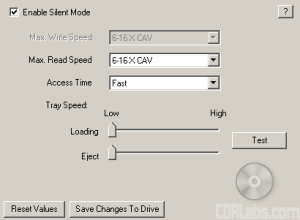 Silent Mode DVD |
The various options are self explanatory. The top two drop-down menus let you set the PX-755UF's maximum reading and writing speeds. Just remember that with the Silent Mode on, the fastest CD read speed available is 40x, even with SpeedRead enabled. The drop-down menu for the access time gives you three options: Fast (60ms), Middle (80ms) and Slow (120ms), with the quietest setting being Slow. Last but not least, the two slider bars along the bottom can be used to adjust the drive's loading and eject speeds.
PlexTools Professional also includes a number of tests that can be used to measure and display the characteristics of the drive and media being used. Along with reading and writing transfer rate tests, it includes a system to check the writing quality of your CD's and DVD's. Called Q-Check, this system can be used to measure a number of different things, including C1/C2 errors, focus and tracking errors, beta/jitter rates and PI/POF errors.
The first function of Q-Check is to measure the number of C1/C2 errors on a CD. After clicking the Start button, the test will begin. The graph you see represents the C1 error measurement (BLER or BLock Error Rate) and C2 error measurement (E22).
Q-Check C1/C2 Test
If your discs have C1 errors, don't worry. They are normal and in most cases are easily correctable. What you don't want to see are C2 errors. While these errors can be caused by things like scratches and finger prints, they can also be an indication of poor, or low quality, media. If you see CU errors after running this test, you might as well toss the disc in the trash. These are the errors still present after C2 level correction has done its job.
Secondly, you have the focus and tracking error test, or FE/TE test. While the other Q-Check tests can measure the writing quality, this one reports on the mechanical characteristics of the blank media you're trying to use. Keep in mind that this test only works with CD-R, DVD+R and DVD-R discs. Rewritable and double layer media is not supported.
Q-Check FE/TE Test
The Focus Error represents how accurately the laser can stay focused on the disc. With a good disc, the number of focus errors will stay very low across the entire disc. The Tracking Error indicates how well the laser can follow the groove manufactured into the disc. For the best results, this line on the graph should remain relatively flat.
Q-Check can also be used to measure jitter and beta rates. When you record a CD or DVD, the drive burns a series of small "pits" into the dye on the bottom of the disc. The unburned areas between the pits are known as the "lands." The length of the pits and lands is set in the Red Book Standard. Any variation between what has been set in the standard and what has been written to the disc is called "Jitter". To put it simply, the lower the jitter rate the better.
Q-Check Beta/Jitter Test
The Beta rate represents the transitions between the pits and lands. If the laser power is too high, the drive will create pits that are too large. If the laser power is too low, the pits and lands can become blurred. In both cases, the result is the same: a disc that might not be readable in all drives. A Beta rate represented by a horizontal line would indicate a disc in perfect balance.
The PX-755UF also supports PI/PO testing. Where the C1/C2 tests reported the writing quality of CD's, this Q-Check test does the same for DVD's. With PlexTools Professional you can perform four separate tests: SUM8, SUM1, Basic and Burst.
Q-Check PI/PO SUM8 Test
Along with the number of POF (Parity Outer Fail) errors, the SUM8 test will report the number of PI (Parity Inner) errors per 8 consecutive blocks. These are the number of errors before correction and are normal. As long as they stay within acceptable limits, they can usually be corrected by the drive. POF errors are a different story altogether. You don't want to see these uncorrectable errors at all since they can cause data loss.
Q-Check PI/PO SUM1 Test
Where the SUM8 test reported the number of PI errors before correction, the SUM1 test measures the number of errors after correction, or PIF (Parity Inner Fail). While not as bad as POF errors, they can decrease the playability of a disc.
Q-Check PI/PO Basic Test
Q-Check also includes a Basic PI/PO test. Like the Sum1 test, the ECC sum is set to 1. However, instead of measuring the number of PIF errors, the Basic test counts the number of bytes corrected during the PI stage.
Q-Check PI/PO Burst Test
Last but not least, the Burst Test checks for consecutive errors that can influence the error correction. As you can see, it not only reports the number of PIE and POF errors per 8 consecutive blocks, it also gives you the number of POE, or Parity Outer Errors.
The PX-755UF can also perform a TA, or Time Analysis, test. According to Plextor, this test "measures the quality of the written DVD media by checking the pits and lands for compliance with the DVD specifications." It compares the time intervals between two successive pit/land transitions on the disc to those listed in the standard. The test does this for all lengths between 3T and 11T, and 14T.
Before you run the TA test you have to choose the area of the disc you want tested (inner, middle, outer) and the layer if you're using DVD±R DL media. Once the test is run, you'll see a graph like the one below.
Q-Check TA Test
A disc with good writing quality will produce graphs with narrow peaks and little peak shift. As the writing quality gets poorer, the peaks will get wider and eventually run together. In case you're not sure where your results fall, Q-Check automatically scores the jitter and peak shift, giving an overall quality indicator ranging from Bad to Excellent.
More Features:
By looking at the picture below, you can see that Plextor's new DVD writer is identified as a "PLEXTOR DVDR PX-755A".
The Nero screenshot also shows that the PX-755UF has a maximum CD writing speed of 48x and a 2048KB buffer. This buffer is also backed up by Sanyo's BURN-Proof buffer underrun protection. According to Nero, the drive can also write CD-Text and overburn. When testing the drive's capacity, it had no problems overburning up to 99 minutes with our CompUSA media.
Using Alex Noe's Weak Sector Utility we were able to determine that the PX-755UF is a "no sheep" burner. This means that the drive is not a very good choice if you plan to back up titles protected by SafeDisc 2 or later.
Here is a screen shot from Nero's InfoTool. This program queries the drive to see what its reading and writing capabilities are. InfoTool had no problems detecting the PX-755UF's maximum reading and writing speeds, recording modes, buffer underrun protection and 2MB buffer.
InfoTool also shows that the PX-755UF is an RPC-2 DVD drive. This means that the drive's region is stored in the firmware. The drive's region can be changed five times and after that it cannot be changed anymore. A patched RPC-1 firmware can be downloaded here. Just keep in mind that it is not supported by Plextor nor by CDRLabs. Use it at your own risk.
While InfoTool gives us a quick glance at the PX-755UF's features, DVDINFOpro provides a little more information on some of the drive's reading and writing capabilities. By looking at the screenshot above you can see that while Plextor's new drive can read and write to both DVD+R DL and DVD-R DL media, it does not support the Mt. Rainier format.
The PX-755UF also supports a feature called "bitsetting." Using programs like CD Speed or PlexTools Professional, you can set the book type of both DVD+R and DVD+R DL media to "DVD-ROM". For whatever reason though, the drive does not let you set the book type of DVD+RW discs.
Plextor has once again turned to Roxio for their software bundle. The DVD that comes with the PX-755UF contains Roxio's Easy Media Creator 8 suite.
With Easy Media Creator 8, users can quickly and easily do a number of tasks. From the main menu, they have the ability to create their own CD's and DVD's, make copies of existing discs, backup their computer or even organize their photos, videos and music. The menu below shows the various applications that make up the suite.
Easy Media Creator 8 includes what Roxio calls "Creator Classic" and "Music Disc Creator". While not as robust as disc mastering applications like Nero, these two programs will have you creating your own custom data and audio discs in no time.
Roxio also includes their packet writing software, Drag-to-Disc, with Easy Media Creator 8. Drag-to-Disc lets a person write to CD or DVD media the same way they would a floppy disk or hard drive. It also supports most CD and DVD media, including write once formats like CD-R, DVD-R and DVD+R.
Video editing duties are handled by VideoWave. This easy to use software lets you trim your video clips and spruce them up by adding things like transitions, titles, music, and special effects. When you're done, simply save your movie to your hard drive or burn it to disc using MyDVD.
MyDVD is Roxio's DVD authoring application. With this program you can easily edit and then burn your favorite videos to CD or DVD.MyDVD will also allow users to add video effects, transitions and background music, create animated menus, and organize clips and photos into custom slide shows.
Roxio's PhotoSuite software gives you the ability to repair, enhance and share your digital photos. It also includes a number of automated and advanced photo editing tools that will let you easily crop and rotate your pictures, remove things like red-eye and wrinkles and add text and special effects.
Easy Media Creator 8 also includes Roxio's backup software, BackUp MyPC. This easy to use program lets you backup files, folders or entire drives to a number of storage devices, including CD and DVD writers.Backup jobs can be launched manually or scheduled to run at regular intervals so the data is always protected.
Last but not least, you have Sonic's DVD playback software, CinePlayer. Along with DVD movies, CinePlayer can be used to play back your VCD's, SVCD's or whatever video files you might have on your hard drive.
Like Plextor's other "Premium" drives, the PX-755UF isn't short on features. The drive supports most CD and DVD formats and offers specs like 16x DVD±R, 8x DVD+RW, 6x DVD-RW, 10x DVD+R DL and 6x DVD-R DL writing speeds and a maximum DVD read speed of 16x. Of course, Plextor's new external drive isn't just about speed. Along with support for both USB 2.0 and FireWire, the PX-755UF features many of the technologies we've come to expect from Plextor as well as more advanced ones like GigaRec, AUTOSTRATEGY and the Q-Check testing system. With all this, it's easy to see why the Plextor PX-755UF gets the full 10 points for its features.
Plextor's new external DVD writer was very easy to install. Thanks to its support for both USB 2.0 and FireWire, the entire installation process took only a matter of minutes. With no jumpers to worry about, it was as simple as connecting the USB (or FireWire) cable, plugging in the power cable, and powering the drive on. Once connected to our test computer, it took only a matter of seconds for plug and play to install the necessary drivers. After making sure that the drive was recognized correctly in the Device Manager, I was ready to start installing the software.
Software Installation:
As I mentioned earlier, the PX-755UF comes with a DVD full of software from Roxio. If you have autorun enabled on your computer, the menu shown below will appear when you insert the disc.
From here you can access the manual, register your drive or install the bundled software. Simply click the name of the application you want to install, and its setup program will start up automatically.
If you have installed Roxio's Easy Media Creator before, you're probably already familiar with the installation process. All you need to do is choose what language you want and select your installation options.By default the setup program will install the entire suite onto your computer. If you don't want to install everything, select the custom installation. From here you can choose just the components you want.
Documentation:
The bulk of the PX-755UF's documentation is located on the software CD in electronic format. Similar to the ones included with Plextor's other DVD writers, the manual starts out by getting the user familiarized with their new drive. The first section goes over the drive's capabilities, features and system requirements. Plextor has also provided some pretty good diagrams showing the various buttons and connectors located on the front and back of the drive. Everything is labeled clearly and the functions of each are easy to understand.
From here, the manual jumps right into the physical installation of the PX-755UF. The instructions are pretty brief since there really isn't much to do other than plug in a few cables and turn the computer on. Even then, Plextor has provided a nice diagram showing how the drive should be hooked up. The manual continues on by going over the basic operation of the PX-755UF. Along with information on how to use and maintain the drive, there is a short list of frequently asked questions. Last but not least, you have a list of specifications and recommended media. Unfortunately, the manual contains very little information on the PX-755UF's more advanced technologies. For this, you'll want to look at the manual for PlexTools Professional.
The PX-755UF also comes with a "Quick Reference Guide." This small, fold out guide takes the user step by step through the installation process. While a little short on words, Plextor has provided a few diagrams showing how the drive should be hooked up. For most people, the "Quick Start Guide" will be all they'll need to get the PX-755UF up and running.
Like the other Plextor drives I've reviewed, the PX-755UF was very easy to install. Thanks to its FireWire and USB 2.0 interface, it's as simple as plugging in a few cables and flipping a switch. Nevertheless, if you do run into trouble, the documentation Plextor has provided is quite good, even though it is in electronic format. Overall, I give the installation a solid 9 out of a possible 10.
While CPU, memory, OS and other variables don't often make a huge difference, there are some nonetheless. We have a computer that is used only for testing hardware. We do this so all tests can be compared reliably.
Test System:
| CPU: | AMD Athlon 64 3200+ 2.0GHz | |
| Motherboard: | ASUS K8V SE Deluxe with BIOS 1003 | |
| Memory: | 2 x 256MB Kingston PC3200 | |
| Video Card: | XFX NVIDIA GeForce FX5200 - ForceWare v56.72 | |
| Hard Drive: | Hitachi Deskstar 7K80 80GB SATA 7200RPM | |
| Operating System: | Windows XP SP2 - VIA Hyperion Pro v5.04 |
For DVD writers the performance tests are broken down into four sections: CD read, CD write, DVD read and DVD write tests. Each benchmark test has been run three times. The score given is an average of the three. DMA has been enabled in device manager for all IDE devices supporting it.
CD Read Tests: For the read performance section of the CD-ROM benchmarks, CD WinBench 99 v3.0 and CD Speed v4.70 are used to test read speeds, seek times and CPU usage. For DAE testing both CD Speed and CD DAE are used. CD Speed is used to give an overall DAE speed rating and CD DAE is used to give the track by track extraction speeds and to check the extracted tracks for errors the drive may have created.
CD Write Tests: To test the write speeds, Nero Burning Rom is used to write 700MB to our test media. Times are recorded. To test rewrite scores, Nero is used again to time how long it takes to write 400MB of random files and directories. Then Sonic's DLA is used to test packet writing speeds. The same files are copied and pasted in Windows Explorer and timed.
DVD Read Tests: For the read performance section of the DVD benchmarks CD Speed v4.70 is used to test read speeds, seek times, and CPU usage.
DVD Write Tests: To test the DVD write speeds, Nero Burning Rom is used to write 4GB to our test media. Times are recorded. Then Sonic's DLA is used to test packet writing speeds. The same files are copied and pasted in Windows Explorer and timed.
As I pointed out earlier, the PX-755UF has both FireWire and USB 2.0 connectors. To save time, our tests have been run using USB 2.0.
CD Winbench 99 Scores:
| Plextor PX-755UF |
ASUS DRW-1608P3S |
LG GSA-H10N |
Lite-On SHM-165H6S |
|
| CD Winbench 99 | 1530 KB/sec | 1218 KB/sec | 1190 KB/sec | 1817 KB/sec |
| Transfer Rate: Inside | 3060 KB/sec | 2800 KB/sec | 3183 KB/sec | 2990 KB/sec |
| Transfer Rate: Outside | 6400 KB/sec | 5730 KB/sec | 6350 KB/sec | 6578 KB/sec |
| Random Access Time | 101ms | 107ms | 106ms | 106ms |
| CPU Utilization | 1.25% | 0.33% | 0.58% | 0.34% |
The CD Winbench test is as close as we can get to testing every day usage. It fires off eight different applications using scripts. This tries to mimic the activities of a person loading these programs onto their own computer.
Plextor's new DVD writer performed very well in our CD Winbench tests. In the transfer rate tests, the PX-755UF started reading at 23.7x (3400 / 150) on the inside and reached a maximum speed of about 46.4x (6960 / 150) on the outside. This resulted in a very good overall CD Winbench score.
CD Speed v4.70 - Pressed CD:
For this test I used a pressed CD containing one Mode 1 data track. The disc is 74:38 in size and is full of data and directories.

SpeedRead Enabled

SpeedRead Disabled
| Plextor PX-755UF |
ASUS DRW-1608P3S |
LG GSA-H10N |
Lite-On SHM-165H6S |
|
| Transfer Speed Average: Start: End: |
36.76x 21.29x 48.61x |
31.61x 18.12x 41.49x |
35.57x 20.42x 46.78x |
36.68x 21.95x 48.50x |
| Seek Times Random: 1/3: Full: |
94ms 114ms 169ms |
113ms 129ms 202ms |
114ms 130ms 175ms |
103ms 116ms 168ms |
| CPU Usage 1x: 2x: 4x: 8x: |
0% 1% 2% 6% |
0% 1% 2% 4% |
1% 1% 3% 21% |
2% 4% 7% 12% |
PX-755UF performed very well when reading pressed CD's. With SpeedRead enabled, the drive had no problems reading our test disc at 48x. Looking at the other scores, you can see that its seek times and CPU usage were also quite good.
CD Speed v4.70 - CD-R Media:
For this test I made a copy of our pressed test CD. I used 12x rated Memorex Gold 74 minute media for the tests.
| Plextor PX-755UF |
ASUS DRW-1608P3S |
LG GSA-H10N |
Lite-On SHM-165H6S |
|
| Transfer Speed Average: Start: End: |
36.56x 21.01x 48.47x |
31.99x 18.37x 42.48x |
36.30x 20.76x 47.85x |
37.50x 21.74x 49.67x |
| Seek Times Random: 1/3: Full: |
95ms 115ms 177ms |
126ms 136ms 221ms |
113ms 132ms 205ms |
106ms 120ms 184ms |
| CPU Usage 1x: 2x: 4x: 8x: |
0% 1% 3% 5% |
0% 1% 2% 4% |
1% 2% 3% 21% |
2% 5% 8% 13% |
The PX-755UF was a little slower when reading CD-R media. While it still had no problems reaching its rated speed, it wasn't as fast as the SHM-165H6S this time around. Nevertheless, its seek times were again quite good.
Plextor's new DVD writer had no problems recognizing our 99 minute CompUSA media. With SpeedRead enabled, the PX-755UF read our test disc from start to finish, reaching a maximum transfer speed of 48.48x.
The PX-755UF slowed down considerably when reading discs recorded with GigaRec. As you can see, the drive had a maximum read speed of only 8x when reading these discs.
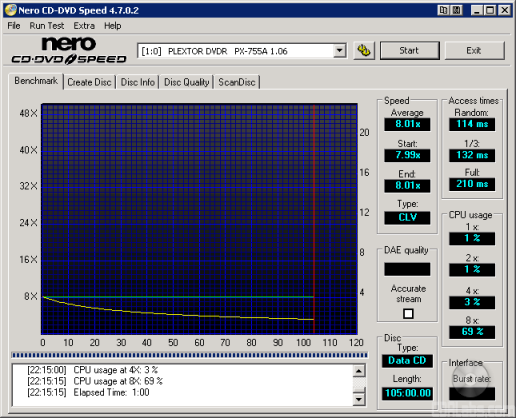
CD Speed v4.70 - CD-RW Media:
For this test I made a copy of a pressed test CD. I used some PNY 80 minute CD-RW media for the tests.
| Plextor PX-755UF |
ASUS DRW-1608P3S |
LG GSA-H10N |
Lite-On SHM-165H6S |
|
| Transfer Speed Average: Start: End: |
31.56x 18.40x 41.68x |
25.16x 14.67x 33.23x |
30.58x 17.66x 40.13x |
25.56x 15.01x 33.75x |
| Seek Times Random: 1/3: Full: |
99ms 120ms 169ms |
126ms 142ms 214ms |
112ms 129ms 182ms |
111ms 128ms 190ms |
| CPU Usage 1x: 2x: 4x: 8x: |
0% 1% 3% 5% |
0% 1% 2% 4% |
1% 2% 3% 16% |
3% 6% 12% 21% |
The PX-755UF's CD-RW read speeds were limited to only 40x, even with SpeedRead enabled. Nevertheless, the drive had no problems exceeding this speed in CD Speed's transfer rate tests and its seek times were again very good.
CD DAE and CD Speed v4.70 - Pressed CD:
For this test I used Pure Funk. The CD is almost exactly 74 minutes. This helps to squeeze the maximum performance out of the CD.

Exact Audio Copy can tell us a lot about a drive's capabilities. You can see from the screen shot that the Plextor PX-755UF supports accurate stream, caches audio data and has the ability to retrieve C2 error information from audio CD's.
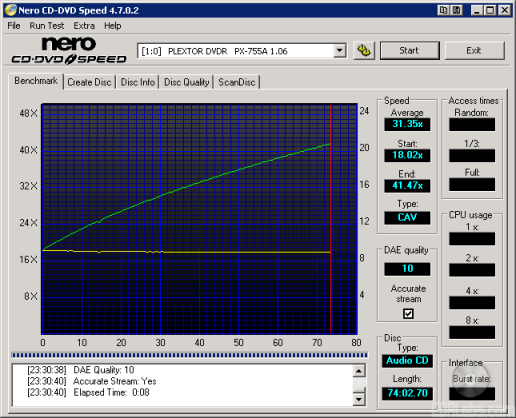
| CD Speed | Plextor PX-755UF |
ASUS DRW-1608P3S |
LG GSA-H10N |
Lite-On SHM-165H6S |
| Average: Start: End: DAE Quality: Accurate Stream: |
31.35x 18.02x 41.48x 10 Yes |
31.15x 18.77x 41.38x 10 Yes |
30.73x 17.95x 40.68x 10 Yes |
37.03x 21.26x 48.93x 10 Yes |
The PX-755UF did fairly well in our DAE tests. While not nearly as fast as the drive from Lite-On, it hadno problems ripping pressed audio CD's at 41x.
To get a better look at the quality of the extracted audio we use CD DAE. CD DAE is actually designed to be an audio ripping program. It converts the CD-DA on the CD to .wav files. We use it in our testing because it can also be used as a quick and easy way to test the quality. Where CD Speed tests the DAE as one large session, CD DAE extracts each CD track individually. It actually extracts each track twice and then compares them to check for any errors. Every error a drive creates could be a hiss or pop you would hear later in the audio tracks.
| CD DAE | Plextor PX-755UF |
ASUS DRW-1608P3S |
LG GSA-H10N |
Lite-On SHM-165H6S |
| Average: Min: Max: |
29.7x 18.4x 40.6x |
29.3x 18.7x 40.1x |
29.0x 18.4x 39.8x |
34.5x 22.3x 47.9x |
| Errors | 0 | 0 | 0 | 0 |
While the PX-755UF started out fairly quick when extracting our test CD with CD DAE, its average and maximum speeds were slower than what we saw with CD Speed.
CD DAE and CD Speed v4.70 - CD-R Media:
For this test I used a copy of the Pure Funk CD. It's burned onto the same Memorex Gold 74 minute media I used in the CD Speed tests.
| CD Speed | Plextor PX-755UF |
ASUS DRW-1608P3S |
LG GSA-H10N |
Lite-On SHM-165H6S |
| Average: Start: End: DAE Quality: Accurate Stream: |
31.52x 18.40x 41.56x 10 Yes |
31.14x 18.81x 41.33x 10 Yes |
30.48x 17.94x 40.27x 10 Yes |
36.59x 21.69x 48.24x 10 Yes |
The PX-755UF was slightly faster when ripping audio CD-R discs. Unfortunately, even with this increase in speed, it wasn't nearly as fast as the Lite-On SHM-165H6S. So how did it do in CD Speed's advanced DAE tests? Take a look below.
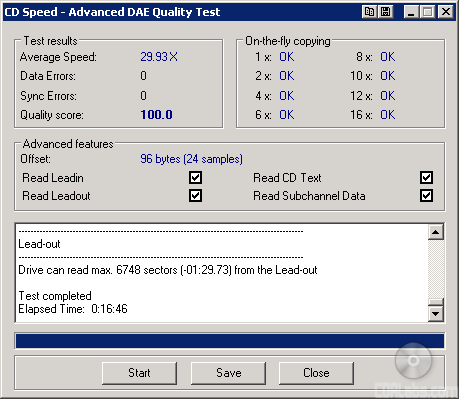
Plextor's new DVD writer completed CD Speed's advanced DAE tests with an average score of 29.93x. The drive had no problems passing all of the on-the-fly tests and did not create any errors. In the advanced tests, the PX-755UF was able to read the CD-Text and subchannel data as well as the lead in and lead out sections of the CD.
| CD DAE | Plextor PX-755UF |
ASUS DRW-1608P3S |
LG GSA-H10N |
Lite-On SHM-165H6S |
| Average: Min: Max: |
29.9x 19.2x 40.8x |
29.3x 18.9x 40.0x |
28.8x 18.4x 39.3x |
34.2x 22.3x 47.4x |
| Errors | 0 | 0 | 0 | 0 |
To see how well Plextor's DVD writer can read scratched and dirty discs, I used CD Speed's ScanDisc utility to see how many sectors were damaged or unreadable. This is a very rough, but good way to test the drive's error correcting abilities.

CD Speed - ScanDisc
The PX-755UF handled scratched discs relatively well. By looking at the screenshot, you can see that the drive considered only 68.7% of the CD to be "damaged". More importantly, none of the sectors on the disc were unreadable.
You can also get an idea of how well the drive can read scratched and dirty discs by using CD DAE. CD DAE will extract the audio tracks twice and then compare them. From this information we can see what the drive's average speed was and how many errors it generated.
| CD DAE | Avg. Speed | Errors | % of Disc |
|
Plextor PX-755UF |
23.1x | 123601935 | 15.77% |
|
ASUS DRW-1608P3S |
17.4x | 11131500 | 1.42% |
|
LG GSA-H10N |
28.7x | 37659512 | 4.81% |
|
Lite-On SHM-165H6S |
1.8x | 2069367 | 0.26% |
The PX-755UF gave some mixed results in this test. While the scratches on the disc didn't slow the drive down very much, the number of errors was higher than what we'd like to see.
CD Write and ReWrite Tests - Nero Burning Rom 6.6.1.4 andDLA 4.95:
For this test I randomly generated 650MB and 700MB of files and directories to test the time it takes the drive to write and close a CD. All of the files are between 1MB and 25MB in size and no more than 10 directories deep. All of the times below include not only the actual writing time, but the lead in and out times too. This gives a more realistic idea of how long it takes to write a CD.

The PX-755UF has a maximum CD writing speed of 48x. To reach this speed, it uses CAV, or Constant Angular Velocity. With Fuji's 48x media, the drive started writing at about 21.53x and reached a maximum speed of 48.55x at the end of the session. This gave Plextor's new DVD±RW an average writing speed of about 36.76x.
To test the drive's writing times, I wrote our test data to some Taiyo Yuden manufactured Fuji media rated at 48x. The results are below.
| Size in MB | Size in Time | Plextor PX-755UF |
ASUS DRW-1608P3S |
LG GSA-H10N |
Lite-On SHM-165H6S |
| 701MB | 79:44:21 | 2:42 | 3:33 | 3:05 | 2:44 |
Plextor's's new drive did very well in our CD writing tests. Thanks to its 48x CD writing speed, the PX-755UF was able to write an entire 700MB CD in 2:42, beating the drives from ASUS and LG by more than 20 seconds.
To test the PX-755UF's writing quality I used the Q-Check C1/C2 Test built into PlexTools Professional. This test can be used to give us the average, maximum and total number of C1, C2 and CU (uncorrectable) errors on a disc. For these tests, the drive's read speed has been set to 24x. For comparison, I've also included test results from Lite-On IT's KProbe2.
|
|
|
||||||||||||||||||||||||||||||||||||||||||||||||||||||||||||||||||||||||
The PX-755UF's writing quality was very good. By looking at the screenshots, you can see that the number of C1 errors stayed relatively low. More importantly, there were no C2 or CU errors on any of the discs I tested.
For the rewriting tests I created 400MB of files on the hard drive and wrote them in DAO mode using Nero. To test the packet writing speeds I copied and pasted the same files off the hard drive onto a CD-RW disc using DLA from Sonic. Verbatim's 32x Ultra Speed CD-RW media was used for these tests.
While the PX-755UF uses CAV when writing to CD-R discs, it uses Z-CLV, or Zone CLV, when rewriting at 24x. The drive starts rewriting at about 20x and then jumps to its maximum speed at the 7 minute mark..
| Software | Plextor PX-755UF |
ASUS DRW-1608P3S |
LG GSA-H10N |
Lite-On SHM-165H6S |
| Nero | 2:24 | 2:52 | 2:14 | 2:37 |
| DLA Write | 2:25 | 2:40 | 2:12 | 2:39 |
| DLA Read | 1:33 | 5:21 | 1:16 | 1:41 |
Plextor's new drive performed surprisingly well considering it rewrites at only 24x. While not as fast as the drive from LG, the PX-755UF took 2:24 to write 400MB with Nero and 2:25 to do the same with DLA.
| Plextor PX-755UF |
ASUS DRW-1608P3S |
LG GSA-H10N |
Lite-On SHM-165H6S |
|
| Quick Erase | 19 seconds | 22 seconds | 15 seconds | 26 seconds |
| Full Erase | 4:12 | 3:46 | 3:08 | 3:58 |
The PX-755UF also erases at 24x. While this didn't have much of an effect on the drive's quick erase times, it took more than four minutes to do a full erase.
Nero CD Speed v4.70 - DVD-ROM:
A little editorial note here. Like a CD-ROM, you will get different benchmark results depending on what kind of discs you are using. You are probably going to get varying results from a full data disc to a single layer movie disc. You're also going to get different results for single and dual layer discs.
The CD Speed website recommends using a single layer DVD-ROM disc with a capacity of at least 4GB. If you use a dual layer disc you probably won't get the best results because most DVD-ROM drives slow down to read them. Some even slow down to read single layer DVD-Video discs. To make a long story short, I am using a 4.37GB single layer, single sided disc for this test.
| Plextor PX-755UF |
ASUS DRW-1608P3S |
LG GSA-H10N |
Lite-On SHM-165H6S |
|
| Transfer Speed Average: Start: End: |
12.05x 6.63x 16.12x |
12.01x 6.65x 16.11x |
12.31x 6.80x 16.46x |
12.11x 6.45x 16.20x |
| Seek Times Random: 1/3: Full: |
114ms 132ms 212ms |
117ms 140ms 218ms |
103ms 120ms 187ms |
115ms 135ms 213ms |
| CPU Usage 1x: 2x: 4x: 8x: |
6% 12% 23% 44% |
4% 8% 15% 48% |
6% 11% 22% 42% |
9% 9% 20% 96% |
The PX-755UF performed pretty well when reading single layer DVD-ROM's. In our tests it started reading at 6.63x and reached a maximum transfer speed of about 16.12x.
Nero CD Speed v4.70 - DVD-R and DVD-RW:
First, we'll look at the drive's DVD-R and DVD-RW reading performance. For this I made copies of our DVD-ROM test disc using some general use 4x DVD-R and 2x DVD-RW media from Verbatim and then ran our usual DVD read tests with CD Speed. The results are below.
Verbatim DVD-R
| Plextor PX-755UF |
ASUS DRW-1608P3S |
LG GSA-H10N |
Lite-On SHM-165H6S |
|
| Transfer Speed Average: Start: End: |
9.04x 4.99x 12.10x |
9.38x 5.20x 12.51x |
12.35x 6.83x 16.52x |
9.20x 5.04x 12.29x |
| Seek Times Random: 1/3: Full: |
123ms 146ms 213ms |
116ms 13ms 220ms |
108ms 125ms 176ms |
125ms 136ms 229ms |
| CPU Usage 1x: 2x: 4x: 8x: |
6% 12% 23% 43% |
5% 9% 17% 56% |
6% 11% 22% 42% |
5% 8% 25% n/a |
Verbatim DVD-RW
| Plextor PX-755UF |
ASUS DRW-1608P3S |
LG GSA-H10N |
Lite-On SHM-165H6S |
|
| Transfer Speed Average: Start: End: |
9.06x 4.98x 12.12x |
6.26x 3.45x 8.37x |
10.03x 5.55x 13.40x |
9.20x 5.05x 12.30x |
| Seek Times Random: 1/3: Full: |
121ms 151ms 228ms |
115ms 138ms 225ms |
128ms 150ms 217ms |
110ms 120ms 202ms |
| CPU Usage 1x: 2x: 4x: 8x: |
7% 12% 22% 43% |
5% 9% 19% 39% |
6% 11% 22% 57% |
5% 9% 27% n/a |
Plextor's new drive wasn't nearly as fast when reading DVD-R and DVD-RW media. In both cases, the PX-755UF reached a maximum transfer speed of about 12.1x.
Verbatim DVD-R DL
| Plextor PX-755UF |
ASUS DRW-1608P3S |
LG GSA-H10N |
Lite-On SHM-165H6S |
|
| Transfer Speed Average: Start: End: |
6.04x 3.35x 8.06x |
5.70x 3.18x 7.60x |
9.27x 5.16x 12.36x |
6.05x 3.37x 8.06x |
| Seek Times Random: 1/3: Full: |
145ms 175ms 248ms |
115ms 142ms 224ms |
132ms 156ms 220ms |
124ms 130ms 221ms |
| CPU Usage 1x: 2x: 4x: |
6% 10% n/a |
4% 8% n/a |
6% 12% 43% |
6% 9% n/a |
The PX-755UF had no problems reading Verbatim's 4x DVD-R DL media. In our tests it started reading at 3.35x and reached a maximum transfer speed of 8.06x.
Nero CD Speed v4.70 - DVD+R and DVD+RW:
Next we'll look at the drive's DVD+R and DVD+RW reading performance. For this I made a copy of our DVD-ROM test disc using some 4x DVD+R and 2.4x DVD+RW media from Verbatim. I then ran our usual DVD read tests with CD Speed. The results are below.
Verbatim DVD+R
| Plextor PX-755UF |
ASUS DRW-1608P3S |
LG GSA-H10N |
Lite-On SHM-165H6S |
|
| Transfer Speed Average: Start: End: |
9.04x 4.98x 12.08x |
9.37x 5.20x 12.54x |
12.33x 6.80x 16.50x |
9.17x 5.09x 12.27x |
| Seek Times Random: 1/3: Full: |
122ms 142ms 223ms |
119ms 139ms 220ms |
107ms 127ms 185ms |
101ms 109ms 185ms |
| CPU Usage 1x: 2x: 4x: 8x: |
6% 12% 22% 43% |
5% 8% 16% 64% |
6% 12% 22% 42% |
10% 7% 25% n/a% |
Verbatim DVD+RW
| Plextor PX-755UF |
ASUS DRW-1608P3S |
LG GSA-H10N |
Lite-On SHM-165H6S |
|
| Transfer Speed Average: Start: End: |
9.05x 4.98x 12.11x |
6.26x 3.45x 8.37x |
10.03x 5.54x 13.39x |
9.22x 5.11x 12.33x |
| Seek Times Random: 1/3: Full: |
121ms 139ms 228ms |
115ms 131ms 216ms |
128ms 149ms 215ms |
106ms 122ms 195ms |
| CPU Usage 1x: 2x: 4x: 8x: |
7% 12% 23% 43% |
5% 8% 18% 38% |
6% 12% 22% 51% |
8% 10% 29% n/a |
The PX-755UF's performance with DVD+R and DVD+RW media was very similar to what we saw with DVD-R and DVD-RW media. Here too the drive reached a maximum read speed of about 12.1x.
Verbatim DVD+R DL
| Plextor PX-755UF |
ASUS DRW-1608P3S |
LG GSA-H10N |
Lite-On SHM-165H6S |
|
| Transfer Speed Average: Start: End: |
6.05x 3.34x 8.07x |
5.70x 3.18x 7.61x |
9.27x 5.16x 12.38x |
6.05x 3.37x 8.07x |
| Seek Times Random: 1/3: Full: |
144ms 173ms 245ms |
126ms 132ms 218ms |
130ms 151ms 218ms |
111ms 124ms 187ms |
| CPU Usage 1x: 2x: 4x: |
6% 12% n/a |
4% 8% n/a |
6% 11% 30% |
6% 8% n/a |
Reading Verbatim's double layer DVD+R media wasn't a problem for the PX-755UF either. While not nearly as fast as the drive from LG, it reached a maximum transfer speed of 8.07x.
Nero CD Speed v4.70 - DVD-Video:
For these tests I am using the US version of Transformers: The Movie on DVD. The disc is over 4GB and single sided.
SpeedRead Enabled
SpeedRead Disabled - "Quiet Mode"
| Plextor PX-755UF |
ASUS DRW-1608P3S |
LG GSA-H10N |
Lite-On SHM-165H6S |
|
| Transfer Speed Average: Start: End: |
12.05x 6.62x 16.12x |
3.89x 2.14x 5.02x |
3.65x 2.02x 4.88x |
11.99x 6.62x 16.04x |
| Seek Times Random: 1/3: Full: |
112ms 130ms 200ms |
107ms 123ms 205ms |
121ms 147ms 219ms |
114ms 122ms 197ms |
| CPU Usage 1x: 2x: 4x: 8x: |
6% 12% 23% 44% |
5% 8% 20% 57% |
6% 11% 21% n/a |
7% 10% 20% 97% |
The PX-755UF has two different modes when reading DVD videos. To reduce noise, the drive reads these discs at 2x by default. While this isn't very fast, you can increase the drive's maximum transfer speed by enabling SpeedRead. With SpeedRead enabled, the PX-760A was able to read single layer DVD videos at 16x and dual layer discs at 12x.
To see how well the PX-755UF worked as a DVD player, I watched a few scenes from Transformers: The Movie and Star Wars: The Phantom Menace using WinDVD 4 and PowerDVD 5. The drive had no problems playing back these movies with either program and was very quiet when SpeedRead was disabled.
DVD Write and ReWrite Tests - Nero Burning Rom 6.6.1.4 andDLA 4.95:
To test the DVD writing performance of Plextor's new drive I used Verbatim 16x DVD+R, 16x DVD-R, 8x DVD+RW and 6x DVD-RW media. To get the writing times, a 4.38GB image was burned to our test discs using Nero.
When writing to DVD+R and DVD-R media at 16x, the PX-755UF uses CAV. By looking at the screenshots above, you can see that Plextor's new drive starts writing at about 6.7x and accelerates, reaching its maximum speed as it reaches the end of the disc.
The PX-755UF also features 8x DVD+RW and 6x DVD-RW writing speeds. While the drive uses CLV when writing to DVD-RW media, it uses P-CAV to reach its maximum DVD+RW writing speed.
| Plextor PX-755UF |
ASUS DRW-1608P3S |
LG GSA-H10N |
Lite-On SHM-165H6S |
|
| DVD+R | 6:22 | 6:16 | 5:38 | 6:07 |
| DVD-R | 6:25 | 6:01 | 5:32 | 6:16 |
| DVD+RW | 7:23 | 7:28 | 7:25 | 8:08 |
| DVD-RW | 10:03 | 10:10 | 9:59 | 10:37 |
The PX-755UF performed pretty well in our DVD writing tests. While not as fast as some of the other drives when writing to DVD+R and DVD-R discs at 16x, it turned in some very good times with DVD+RW and DVD-RW media.
While Plextor has a list of recommended media on their website, I wanted to see for myself how well the PX-755UF worked with some of the DVD+R and DVD-R media currently available.
| Manufacturer ID | Max Write Speed |
Average Write Time |
|
| RiDATA 16x DVD+R | RITEKR04 | 16x | 7:24 |
| Sony 16x DVD+R | SONYD21 | 16x | 6:25 |
| Taiyo Yuden 16x DVD+R | YUDEN000T03 | 16x | 6:19 |
| Verbatim 16x DVD+R | MCC-004 | 16x | 6:22 |
| Memorex 16x DVD-R | CMC MAG.AM3 | 16x | 6:49 |
| RiDATA 16x DVD-R | RITEKF1 | 16x | 8:28 |
| Taiyo Yuden 16x DVD-R | TYG03 | 16x | 6:25 |
| Verbatim 16x DVD-R | MCC 03RG20 | 16x | 6:25 |
While the PX-755UF tried to write to all of our test media at 16x, there were a few cases where Plextor's PoweRec technology prevented it from reaching this speed.
So what about writing quality? Testing a drive's DVD writing quality isn't easy. Until now, there were very few options, unless you wanted to shell out thousands of dollars for a certified test machine. Fortunately, we can test a disc's PI (Parity Inner) and PO (Parity Outer) rates using the PI/PO tests built into PlexTools Professional. For this review, we're going to use the Burst test run at 3-8x using "Middle Accuracy". This willgive us the number of PI Errors (before correction), PO Errors and the number of uncorrectable blocks (POF).
For comparison, I also tested the discs on a BenQ DW1640. When combined with Nero CD Speed, the DW1640 is able to report PI Errors, PI Failures, Parity Outer Failures and jitter levels. For this test, the discs are read at 8x with both the PI and PIF ECC sums set to 8.
I also put these discs through a "stress test" by reading them back at 16x with the DW1640. By reading these discs back at this speed, we can see if there are any readability issues caused by the number of errors or high levels of jitter.
|
|
||||||||||||||||||||||||||||||||||||||||||||||||||||||||
|
|
||||||||||||||||||||||||||||||||||||||||||||||||||||||||
The PX-755UF's writing quality was pretty good with the majority of the DVD+R media we tested. In most cases, the error rates stayed well within acceptable limits, with the only exception being RiDATA's 16x DVD+R media. When tested with Plextools and CD Speed, the PI/PIE rate was a little higher than we'd like to see.
|
|
||||||||||||||||||||||||||||||||||||||||||||||||||||||||
|
|
||||||||||||||||||||||||||||||||||||||||||||||||||||||||
Lastly, here are some results from our DVD-R test media. While the writing quality varied from one manufacturer to another, the results were pretty good for the most part.
| Plextor PX-755UF |
ASUS DRW-1608P3S |
LG GSA-H10N |
Lite-On SHM-165H6S |
|
| DVD+RW Quick | 4 seconds | 5 seconds | 10 seconds | 10 seconds |
| DVD+RW Full | 7:22 | 7:20 | 7:18 | 8:10 |
| DVD-RW Quick | 49 seconds | 1:12 | 27 seconds | 1:02 |
| DVD-RW Full | 10:06 | 10:38 | 9:57 | 10:57 |
To test the PX-755UF's packet writing performance I used DLA 4.95. Verbatim 8x DVD+RW and 6x DVD-RW media were used once again.
| Plextor PX-755UF |
ASUS DRW-1608P3S |
LG GSA-H10N |
Lite-On SHM-165H6S |
|
| DVD+RW Write | 6:28 | 6:31 | 6:31 | 7:19 |
| DVD+RW Read | 9:11 | 8:30 | 7:19 | 9:01 |
| DVD-RW Write | 8:24 | 8:23 | 8:24 | 9:06 |
| DVD-RW Read | 9:16 | 8:57 | 8:42 | 6:45 |
The PX-755UF's packet writing performance was pretty mixed. While it turned in some very good writing times with both DVD-RW and DVD+RW media, it was not as fast as some of the other drives when reading back our test data.
Double Layer DVD Write Tests - Nero Burning Rom 6.6.1.4:
To test the double layer DVD writing performance of the PX-755UF, I used DVD+R DL and DVD-R DL media from Verbatim and RiDATA. I created about 8GB of random files and directories on my hard drive and then burned them to our test discs with Nero.
Finding DVD+R DL media that would work at 10x was not an easy task. The only media we found that would work at this speed were Verbatim's 8x DVD+R DL discs.
| Plextor PX-755UF |
ASUS DRW-1608P3S |
LG GSA-H10N |
Lite-On SHM-165H6S |
|
| DVD+R DL Write | 15:11 | 16:26 | 14:14 | 17:22 |
With Nero, it took the PX-755UF about 15:11 to write 8001MB of data. While faster than the drives from ASUS and Lite-On, it was more than a minute slower than the GSA-H10N. So what about writing quality? Take a look below.
|
|
||||||||||||||||||||||||||||||||||||||||||||||||||||||||
|
|
||||||||||||||||||||||||||||||||||||||||||||||||||||||||
The writing quality was fairly good with Verbatim's 2.4x DVD+R DL media. Aside from a few isolated spikes, the PI/PIF rates stayed within acceptable limits. Unfortunately, the results weren't nearly as good with the other discs. With the8x DVD+R DL media from Verbatim and RiDATA, the PI/PIE rate was very high near the end and there were a small number of PO Failures. Memorex's DVD+R DL media didn't fair any better. While written at a slower speed, the PI/PIF rates were fairly high at the layer change.
The PX-755UF also features 6x DVD-R DL writing speeds. To test the drive's writing times, DVD-R DL media from Verbatim and RiDATA was used.
| Plextor PX-755UF |
ASUS DRW-1608P3S |
LG GSA-H10N |
Lite-On SHM-165H6S |
|
| DVD-R DL Write | 20:42 | 16:56 | 19:12 | 28:04 |
With its 6x writing speed, the PX-755UF wasn't nearly as fast as the drive from ASUS. In our tests, it took Plextor's new drive 27:00 to write 8001MB of data. So what about writing quality? Take a look below.
|
|
||||||||||||||||||||||||||||||||||||||||||||||||||||||||
The PX-760A's writing quality was pretty good with Verbatim's 4x DVD-R DL media. The error rates stayed within acceptable limits and there were no readability problems. Unfortunately, the same can't be said for RiDATA's DVD-R DL media. When scanned with the BenQ DW1640, the PI/PIF rates were quite high and there were a small number of PO Failures.
Performance Revisited:
While not the fastest at everything, the PX-755UF performed as expected throughout most of our tests. The drive had no problems holding its own when writing to DVD±R, DVD±RW and DVD±R DL media. However, writing quality was an issue as the PI/PIF rates were quite high with some DVD±R DL media. On the other hand, the PX-755UF was fairly quick when reading DVD's. In our tests, it was able to read single layer data and video DVD's at 16x and both DVD±R and DVD±RW media at 12x.
Plextor's new DVD writer also did very well in our CD read tests. With SpeedRead enabled, it was able to read all types of media at its rated speeds and had some very good seek times. Writing CD's wasn't a problem for the PX-755UF either. The drive turned in some respectable writing times and its writing quality was quite good. With all things considered, the Plextor PX-755UF gets a solid 7 out of 10 for the performance section of this review.
When drives reach a certain age, manufacturers tend to put them out to pasture. In Plextor's case, they've breathed new life into the nearly one year old PX-755A by reintroducing it as an external model, the PX-755UF. As it is only a 16x DVD±RW, the PX-755UF isn't the fastest drive to come though the 'Labs. However, for an external DVD writer, it offers great all around performance and an impressive number of features.
Like its internal counterpart, the PX-755UF can write to both DVD+R and DVD-R media at 16x. At this speed, it took the drive about 6 and a half minutes to burn an entire 4.7GB DVD. Plextor's new drive also did pretty well in our rewriting tests, turning in some very good times with both DVD-RW and DVD+RW media. Writing to DVD+R DL and DVD-R DL media wasn't a problem for the PX-755UF either. While the drive's 6x DVD-R DL writing speed put it at a disadvantage in some of our tests, it made up for it by burning 8GB of data to a DVD+R DL disc in a little more than 15 minutes.
Finding compatible media really wasn't an issue with the PX-755UF. While there were a few cases where PoweRec kicked in, the drive tried to write to all of our test media at its rated speeds. The PX-755UF's writing quality was also pretty good, at least with single layer DVD±R media. With DVD±R DL media though, there were a number of cases where the PI/PIF rates were very high. I must admit this was a bit surprising considering the age and maturity of the drive design.
Plextor's new drive did pretty well in our DVD read tests. It was able to read both single layer DVD-ROM's and DVD-Videos at 16x and had some relatively good seek times. Reading recordable media wasn't a problem for the PX-755UF either. In our tests, it read both DVD±R and DVD±RW media at 12x and DVD±R DL discs at a respectable 8x.
The PX-755UF was also fairly quick when reading CD's. With SpeedRead enabled, it had no problems reading pressed and CD-R media at 48x and CD-RW discs at 41x. The drive also did pretty well in our DAE tests, reaching a maximum speed of 41x. As a writer, the PX-755UF performed as expected. The drive turned in some impressive times when writing to CD-R media. However, due to its 24x CD-RW writing speed, it wasn't as fast as some of the other drives in our rewriting tests.
When it comes to features, the PX-755UF definitely delivers. Along with old favorites like PoweRec, VariRec and BURN-Proof, the drive supports a number of Plextor's more advanced technologies including Q-Check, GigaRec and AUTOSTRATEGY. The PX-755UF also has the ability to set the booktype of DVD+R and DVD+R DL media and supports both USB 2.0 and FireWire. To top it all off, Plextor has included a great software bundle containing Roxio's Easy Media Creator suite and PlexTools Professional.
The PX-755UF is available now and can be purchased through some of the online vendors listed on Pricegrabber. Prices vary depending on the seller, but Plextor's new external DVD writer can be picked up for around $140.
| Plextor PX-755UF 16x DVD±RW |
|
| Features: Installation: Performance: |
10 9 7 |
| Overall: | 8 |
Highs:
- Writes to DVD-R and DVD+R media at 16x
- Writes to DVD+RW media at 8x
- Writes to DVD-RW media at 6x
- Writes to DVD+R DL media at 10x
- Writes to DVD-R DL media at 6x
- Reads single layer DVD-ROM's at 16x
- Reads DVD±R and DVD±RW media at 12x
- Reads DVD±R DL media at 8x
- Features 48x CD-R and 24x CD-RW writing speeds
- Very good transfer speeds with all types of CD media
- Good DAE speeds
- Low seek times
- Supports GigaRec, SecuRec, PoweRec, VariRec, Silent Mode, AUTOSTRATEGY and Q-Check technologies
- Includes Easy Media Creator 8 and PlexTools Professional
- Features both FireWire and USB 2.0 interfaces
- Supports bitsetting for DVD+R and DVD+R DL media
- Supports 99 minute media
- Good documentation
Lows:
- Questionable writing quality with some DVD±R DL media
- Cannot write to 8x DVD±R media at 16x
- Writes to CD-RW media at only 24x
- Reads GigaRec recorded discs at only 8x
- Cannot set the book type of DVD+RW media
- Has a 2048KB buffer
- Expensive






